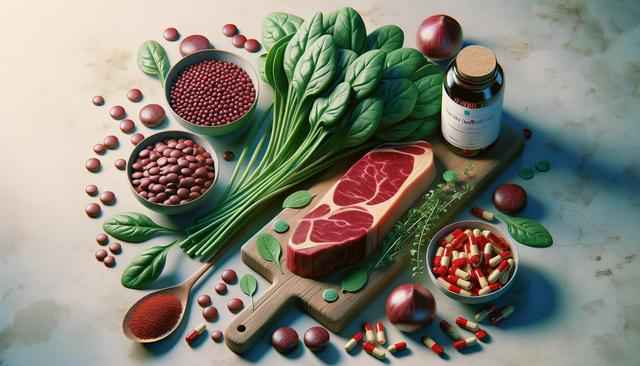Understanding Iron Deficiency and Its Impact
Iron plays a critical role in the body, primarily in the production of hemoglobin, a protein in red blood cells that carries oxygen. When iron levels are low, your body struggles to produce enough healthy red blood cells, leading to iron deficiency anemia. This condition can manifest through a range of symptoms, some of which are easily overlooked. Among the 5 weird signs of iron deficiency are unusual cravings for non-food items (a condition known as pica), restless legs syndrome, cold hands and feet, brittle nails, and frequent headaches. Understanding these indicators can help individuals seek early treatment and avoid more serious health issues.
Iron deficiency can develop gradually, and many may not realize they are affected until symptoms become pronounced. Certain groups, such as menstruating women, pregnant individuals, vegetarians, and those with chronic diseases, are more susceptible. Recognizing the importance of iron in your daily diet and identifying early signs can lead to more effective treatment strategies and better overall health outcomes.
Dietary Changes: The First Step in Treatment
One of the most effective and sustainable ways to treat iron deficiency is through dietary changes. Incorporating iron-rich foods into your daily meals can significantly improve your iron levels over time. Foods high in heme iron, which is more easily absorbed by the body, include meat, poultry, and seafood. For those looking for plant-based options, there are many non-heme iron sources that can also help boost iron intake.
Here are some of the top 10 iron-rich foods you can include in your diet:
- Red meat (especially liver)
- Chicken and turkey
- Shellfish such as clams and oysters
- Spinach
- Lentils
- Tofu
- Pumpkin seeds
- Quinoa
- Chickpeas
- Fortified cereals
For vegetarians, focusing on the top 10 iron-rich foods vegetarian diets can offer is essential. These include lentils, tofu, chickpeas, kidney beans, and dark leafy greens. Combining these with vitamin C-rich foods, like oranges or bell peppers, can enhance iron absorption and support your recovery from iron deficiency.
Iron Supplements: When Diet Isn’t Enough
While dietary changes are a crucial part of treating iron deficiency, some individuals may require iron supplements, especially if their levels are significantly low or if dietary intake alone doesn’t suffice. Iron supplements come in various forms, including ferrous sulfate, ferrous gluconate, and ferrous fumarate. It’s important to follow a healthcare provider’s guidance when starting any supplement regimen to ensure proper dosage and to minimize potential side effects such as constipation or stomach upset.
Supplements are often recommended for:
- Individuals with severe anemia
- Pregnant women with increased iron needs
- People recovering from surgery or blood loss
- Vegetarians or vegans with limited iron sources
Taking supplements with a source of vitamin C can improve iron absorption. However, it’s also crucial to avoid consuming calcium-rich foods or beverages at the same time as iron, as calcium can inhibit its absorption. Monitoring progress through regular blood tests can help determine how well the treatment is working and whether any adjustments are needed.
Medical Treatments and Monitoring
In some cases, medical intervention beyond dietary changes and supplements may be necessary. For individuals who cannot tolerate oral supplements or for whom they are ineffective, intravenous (IV) iron therapy might be recommended. This method delivers iron directly into the bloodstream, offering a faster and more efficient boost, particularly for those with chronic illnesses or severe deficiencies.
Healthcare providers may also investigate underlying causes of iron loss, such as gastrointestinal bleeding, heavy menstrual cycles, or malabsorption syndromes. Addressing these issues is crucial for preventing recurring deficiencies. Regular monitoring of ferritin and hemoglobin levels helps in assessing the effectiveness of the treatment and making necessary adjustments.
It’s essential to work closely with a healthcare professional throughout the treatment process. Self-diagnosing or self-medicating can lead to iron overload, which can be harmful. A tailored treatment plan based on individual needs and medical history ensures a safer and more effective recovery.
Maintaining Iron Levels for Long-Term Health
Once iron levels return to normal, it’s important to maintain them through a balanced diet and lifestyle choices. Continued focus on iron-rich foods for anemia prevention, including both heme and non-heme sources, can help sustain adequate levels and reduce the risk of recurrence.
Here are some tips to maintain healthy iron levels:
- Include a variety of iron-rich foods in your meals
- Pair plant-based iron sources with vitamin C-rich foods
- Avoid consuming tea or coffee with meals, as these can inhibit iron absorption
- Stay informed about your iron status with periodic blood tests, especially if you’re in a high-risk group
By staying consistent with these habits and being mindful of the 5 weird signs of iron deficiency, you can protect your health and energy levels over the long term. Prevention plays a significant role in managing iron deficiency, especially for those with ongoing risk factors.




Leave a Reply